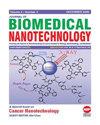miR-421-Loaded Chitosan Nanoparticles Suppress the Malignant Characteristics of Colorectal Cancer Cells
IF 2.9
4区 医学
Q1 Medicine
引用次数: 0
Abstract
Rectal cancer (RC) is a destructive cancer and long-term chemotherapy often leads to decreased drug sensitivity. This study investigates the role of chitosan nanoparticles (NPs) carrying miR-421 in RC and the mechanism underlying its inhibitory effect on malignant characteristics of RC cells through Wnt/β-catenin signaling pathway. miR-421-loaded chitosan NPs were prepared, and then HR8348 cells were divided into model group, control group, chitosan NPs group (nano-group), miR-421 group and chitosan NPs carrying miR-421 group (nano+miR-421 group), Wnt1 overexpression group (pc-Wnt1 group), Wnt1 inhibition group (si-Wnt1 group), and nano+miR-421+si-Wnt1 group, in which the cells received corresponding treatment. After treatment,Wnt1/β-catenin and c-Myc expression in RC cells was detected and the target gene of miR-421 was identified. Various experiments were conducted to assess the malignant biological behavior of RC cells. Chitosan NPs carrying miR-421 significantly suppressed migration and proliferation of RC cells and promoted apoptosis. The advent of miR-421 inhibited the increase of Wnt1/β-catenin expression, while Wnt1 inhibitor, as such, controlled characteristics of RC cells, and the inhibitory role of chitosan NPs carrying miR-421 was the most prominent. The bioinformatics software RegRNA 2.0 predicted Wnt1/β-catenin as the specific target gene regulated by miR-421. Chitosan NPs loaded with miR-421 effectively inhibit RC cell growth through blocking the Wnt1/β-catenin signaling pathway and down-regulating the expression of c-Myc.miR-421 载体壳聚糖纳米粒子抑制结直肠癌细胞的恶性特征
直肠癌(RC)是一种破坏性癌症,长期化疗往往会导致药物敏感性降低。本研究探讨了携带miR-421的壳聚糖纳米颗粒(NPs)在RC中的作用及其通过Wnt/β-catenin信号通路抑制RC细胞恶性特征的机制。制备了载miR-421的壳聚糖NPs,然后将HR8348细胞分为模型组、对照组、壳聚糖NPs组(纳米组)、miR-421组和携带miR-421的壳聚糖NPs组(纳米+miR-421组)、Wnt1过表达组(pc-Wnt1组)、Wnt1抑制组(si-Wnt1组)和纳米+miR-421+si-Wnt1组,细胞分别接受相应的处理。处理后,检测了 RC 细胞中 Wnt1/β-catenin 和 c-Myc 的表达,并确定了 miR-421 的靶基因。实验还对 RC 细胞的恶性生物学行为进行了评估。携带 miR-421 的壳聚糖 NPs 显著抑制了 RC 细胞的迁移和增殖,并促进了细胞凋亡。miR-421的出现抑制了Wnt1/β-catenin表达的增加,而Wnt1抑制剂则控制了RC细胞的特性,携带miR-421的壳聚糖NPs的抑制作用最为突出。生物信息学软件 RegRNA 2.0 预测 Wnt1/β-catenin 是受 miR-421 调控的特异性靶基因。通过阻断Wnt1/β-catenin信号通路和下调c-Myc的表达,负载了miR-421的壳聚糖NPs能有效抑制RC细胞的生长。
本文章由计算机程序翻译,如有差异,请以英文原文为准。
求助全文
约1分钟内获得全文
求助全文
来源期刊
CiteScore
4.30
自引率
17.20%
发文量
145
审稿时长
2.3 months
期刊介绍:
Information not localized

 求助内容:
求助内容: 应助结果提醒方式:
应助结果提醒方式:


